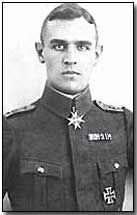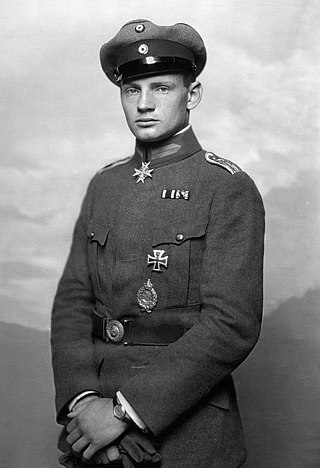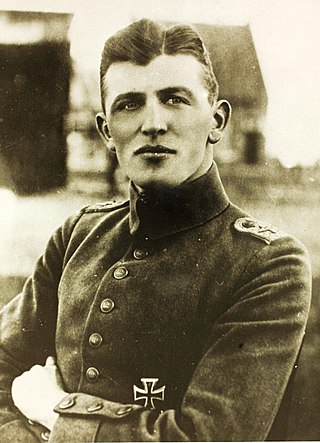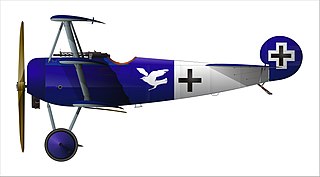Related Research Articles

Franz Büchner PlM was one of the most successful German fighter aces of the First World War, shooting down 40 enemy aircraft. He began his military career as a 16-year-old infantryman. His doughty exploits earned him a battlefield commission just after his 18th birthday, in early 1916. After being wounded and invalided from the infantry, he joined the Imperial German Air Service. Once he progressed to become a fighter pilot flying a Fokker D.VII, he initially struggled to gain his first aerial victories. Something clicked after his fifth victory, and he began to regularly shoot down enemy airplanes, scoring 35 victories between 1 July and 22 October 1918. Most notably, he shot down four SPADs on 26 September. He survived the war, but died in action in 1920 while combating communist revolutionaries near Leipzig.

Heinrich Gontermann was a German fighter ace credited with 39 victories during the First World War.

OberleutnantHenrich Claudius Kroll Pour le Merite, Knight's Cross of the Royal House Order of Hohenzollern, Saxony's Albert Order Knight Second Class with Swords, Iron Cross First and Second Class, was a World War I fighter ace credited with 33 victories.
Generalmajor Hermann Frommherz Military Order of St. Henry, Royal House Order of Hohenzollern, Knight's Cross of the Military Karl-Friedrich Merit Order, began his military career in World War I as a German ace fighter pilot. He was credited with 32 victories. During World War II he was involved in the German takeover of Czechoslovakia and rose to become a Luftwaffe Generalmajor.
Paul Billik was a German World War I fighter ace credited with 31 victories. He was killed in a flying accident while pioneering civil aviation.
LeutnantMax Näther HOH, IC, was a German World War I ace fighter pilot noted for the destruction of 26 enemy aircraft. He shot down 10 observation balloons and 16 airplanes, including 10 SPAD S.XIII fighters and a Sopwith Dolphin. He died in action at the border of Germany and Poland after the war's end on 8 January 1919.
Leutnant Georg von Hantelmann was a German fighter ace credited with winning 25 victories during World War I. It was notable that these victories included three opposing aces shot down within the same week in September 1918–David Putnam, Maurice Boyau, and Joseph Wehner.
Leutnant Fritz Höhn was a German World War I fighter ace credited with 21 victories. He had worked his way up to being a fighter squadron commander, and was eligible for the German Empire's highest award for heroism, the Blue Max, when he was killed in action on 3 October 1918.
Leutnant Arthur Rahn was a German World War I flying ace credited with six aerial victories. He served as a fighter pilot for about two years before being wounded in action on 27 July 1918. Exiting hospital after war's end, he married in 1919. In 1928, the Rahns emigrated to the United States and became naturalized citizens.
Leutnant Viktor Schobinger was a World War I flying ace credited with eight confirmed victories. Victory number two was confirmed over Charles Dawson Booker.
Adjutant-Chef Antoine Laplasse was a World War I balloon buster and flying ace credited with eight aerial victories, six of which were against observation balloons.
Hans-Georg von der Marwitz was a German World War I flying ace credited with 15 aerial victories.

Royal Prussian Jagdstaffel 18 was a "hunting squadron" of the Luftstreitkräfte, the air arm of the Imperial German Army during World War I.
Leutnant Alfred Lindenberger was a World War I flying ace credited with twelve aerial victories. He also scored four victories during World War II while serving as commander of a fighter group.
Leutnant Hans von Keudell was a World War I flying ace credited with twelve aerial victories.

Royal Prussian Jagdstaffel 15, commonly abbreviated to Jasta 15, was a "hunting group" of the Luftstreitkräfte, the air arm of the Imperial German Army during World War I. The unit would score over 150 aerial victories during the war, at the expense of seven killed in action, two killed in flying accidents, three wounded in action, one injured in a flying accident, and two taken prisoner of war.
Oberst Paul Aue was a World War I flying ace from the Kingdom of Saxony in the German Empire. Partial records of his early aviation career credit him with 10 aerial victories. He would join the nascent Luftwaffe during the 1930s and serve Germany through World War II. He died in a Russian prison camp in 1945.
Hermann Vallendor was a German World War I flying ace.
HauptmannPaul Henning Aldabert Theodor von Osterroht IC was a German military aviation pioneer who became a flying ace in World War I. After valorous service as a bomber pilot and commander, he was called upon to found one of the original German Jagdstaffels. By March 1917 he led that unit into combat. Between 29 March and noon of 23 April, he scored seven aerial victories. Six hours later, he was killed in action while on patrol.
Jagdgeschwader II was the Imperial German Air Service's second fighter wing. Established because of the great success of Manfred von Richthofen's preceding Jagdgeschwader I wing, Jagdgeschwader II and Jagdgeschwader III were founded on 2 February 1918. JG II was assigned four squadrons nominally equipped with 14 aircraft each. The new wing was supposed to be fully operational in time for an offensive slated for 21 March 1918. Named to raise and lead it was 23-victory flying ace Hauptmann Adolf von Tutschek. However, he was killed in action on 15 March 1918.
References
- Franks, Norman; Bailey, Frank W.; Guest, Russell. Above the Lines: The Aces and Fighter Units of the German Air Service, Naval Air Service and Flanders Marine Corps, 1914–1918. Grub Street, 1993. ISBN 0-948817-73-9, ISBN 978-0-948817-73-1.
- Franks, Norman; VanWyngarden, Greg; Weal, John. Fokker D VII Aces of World War 1, Part 1: Volume 53 of Aircraft of the Aces: Osprey Aircraft of the Aces. Osprey Publishing, 2003. ISBN 1841765333, 9781841765334.
- Gutmann, Jon. USAS 1st Pursuit Group: Volume 28 of Aviation Elite Units: Volume 28 of Osprey aviation Elite. Osprey Publishing, 2008. ISBN 1846033098, 9781846033094.
- —SPAD XII/XIII Aces of World War 1: Volume 47 of Aircraft of the Aces: Volume 47 of Osprey Aircraft of the Aces. Osprey Publishing, 2002. ISBN 1841763160, 9781841763163.
- VanWyngarden, Greg. JAGDGESCHWADER, Issue 2: Volume 19 of Aviation Elite Units: Volume 19 of Osprey Aviation Elite. Osprey Publishing, 2005. ISBN 1841767271, 9781841767277.